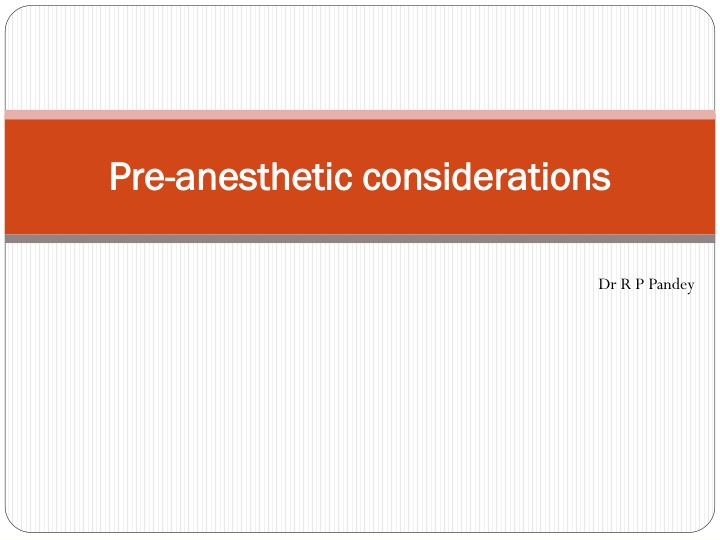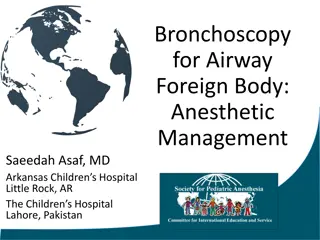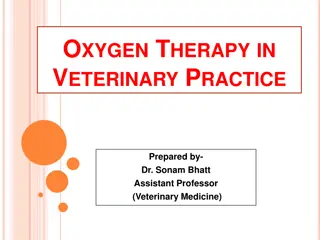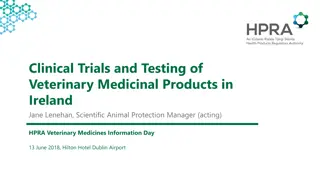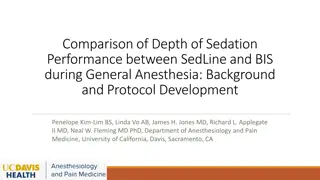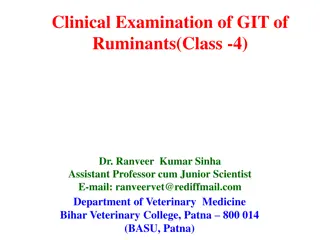Anesthetic Considerations and Clinical Examination in Veterinary Practice
Anesthetizing animals requires careful considerations, such as evaluating the route/method of drug administration, general pre-anesthetic considerations, and conducting a thorough clinical examination. Understanding the effects of drug administration routes, patient evaluation, and clinical examination tips are essential for safe anesthesia delivery in veterinary medicine. Laboratory and other tests play a crucial role in pre-anesthetic assessment to ensure optimal patient care.
Download Presentation

Please find below an Image/Link to download the presentation.
The content on the website is provided AS IS for your information and personal use only. It may not be sold, licensed, or shared on other websites without obtaining consent from the author.If you encounter any issues during the download, it is possible that the publisher has removed the file from their server.
You are allowed to download the files provided on this website for personal or commercial use, subject to the condition that they are used lawfully. All files are the property of their respective owners.
The content on the website is provided AS IS for your information and personal use only. It may not be sold, licensed, or shared on other websites without obtaining consent from the author.
E N D
Presentation Transcript
Pre Pre- -anesthetic anesthetic considerations considerations Dr R P Pandey
EFFECT OF ROUTE /METHOD OF DRUG ADMINISTRATION ON ANAESTHESIA IV Onset is and peak effect is quick, effect is intense, duration of action short Onset in 10-15 min, peak effect is delayed, depends on tissue perfusion/drug absorption/metabolism Intense effect as mixing with blood is less and more drug is available in CNS Unpredictable effect, more drug needed as mixing with blood is more at slow rate Intense effect and increased vascular irritation IM Speedy IV inj. Slow IV inj High concn. sol. Inhalant anesthetics Alveoli to blood to CNS. RR and tidal volume are important for speed of onset and depth
General Considerations Pre General Considerations Pre- -anesthetic and preparation and preparation Done to decide choice and dose of anesthetics. Includes Anamnesis and physical examination. For patient safety open the IV line early and maintain patent airway. Consider species, breed, gender, age, body weight, primary complaint, concurrent diseases and clinical conditions, previous and current medications (especially sulphonamides, chloramphenicol, aminoglycosides, cardiac glycosides, beta blockers, inslulin, anti- epileptic medications). sulphonamides procaine sulphonamide antagonism chloramphenicol effect of anesthesia, mainly barbiturates and tiletamine is prolonged as both utilize same metabolism mechanism anesthetic patient evaluation patient evaluation aminoglycosides cardiac glycosides beta blockers inslulin anti-epileptic medications have NMB effect may alter cardiac monitoring parameters potentiate the effect of NMBs hypoglycemic crisis potentiate the effect of NMBs, tranquillizers, sedatives and anesthetics
Clinical examination (things to look for) Clinical examination (things to look for) General body condition: obesity, cachexia, pregnancy, dehydration Cardiovascular system: heart and pulse rate, rhythm, CRT, arterial pressure, auscultation Respiratory system: RR and depth, tidal volume (approx. 14 ml/kg), mucous membrane pallor cyanosis (indicates >5g/dl Hb unoxygenated), auscultation, upper airway obstruction, consolidation. Liver: jaundice, hepatitis, clotting defects (CTBT) Kidneys: anuria, olignuria, polyuria, polidypsia GIT: abdominal distension, diarrhoea, vomiting, parasitiasis Nervous system & special senses: coma, seizure, glaucoma, disoriented Endocrine and Metalolic state: body temperature, hyper/hypo thyroidism, diabetes Integument: hydration state, neoplasia, ectoparasites, fluid and electrolyte state (burns/trauma) Musculoskeletal system: lethargy, myesthenia, fractures, ambulatory or non ambulatory
PRE PRE ANESTHETIC ANESTHETIC LABORATORY AND OTHER TESTS LABORATORY AND OTHER TESTS CBC, CTBT, plasma protein, glucose, KFT, LFT, electrolytes, urinalysis. ECG, echocardiography Radiography (affected part, thorax, abdomen) Ultrasonography
PATIENT CATEGORIZATION PATIENT CATEGORIZATION Category Physical Status I Normal healthy patients No discernible disease; animals entered for ovariohysterectomy, ear trim, caudectomy, or castration II Patients with mild systemic disease uncomplicated hernia, cryptorchidectomy, localized infection, or compensated cardiac disease III Patients with severe systemic disease moderate hypovolemia IV Patients with severe systemic disease that is a constant threat to life decompensation, emaciation, or high fever V Moribund patients not expected to survive 24 hours with or without surgery E Emergency In clinical emergencies Possible Examples of This Category Skin tumor, fracture without shock, Fever, dehydration, anemia, cachexia, or Uremia, toxemia, severe dehydration and hypovolemia, anemia, cardiac Extreme shock and dehydration, terminal malignancy or infection, or severe trauma
Pre anesthetic patient preparation: Withhold food and water IV fluids for optimal patient support (calorie and water). 10 ml/kg/hr) is the suggested starting point; 20 ml/kg/hr is the upper limit for general fluid support. Correct dehydration, anemia, acidosis, breathing distress, hemostatic defects, renal function, arrhythmias Sps. Food (hrs) Water (hrs) Large dogs/small dogs/cats 12/6-8/6-8 2/-/- Horses (short / long procedures) 24-48/8-12 2/- Ruminants (bovine/camelids/calves, sheep, goat very young and very small sized (2kg) animals Birds (large/medium/small) 18-24/12- 18/8-12 nil 12-18/8-12/8- 12 nil 4/2/- nil
CONDITIONS THAT NEED CORRECTION BEFORE CONDITIONS THAT NEED CORRECTION BEFORE ANESTHESIA ANESTHESIA A. Severe dehydration B. Anemia or hypoproteinemia (Packed cell volume < 20 with acute blood loss, Albumin < 2.0 g/dl) C. Acid-base and electrolyte disturbances (pH < 7.2, Potassium < 2.5 3.0 or > 6.0) D. Pneumothorax E. Cyanosis F. Oliguria or anuria G. Congestive heart failure H. Severe, life-threatening cardiac arrhythmias
FACTORS AFFECTING FACTORS AFFECTING ANESTHETIC (ABSORPTION/UPTAKE, DISTRIBUTION AND ELIMINATION) (ABSORPTION/UPTAKE, DISTRIBUTION AND ELIMINATION) - - 1 1 ANESTHETIC ACTION ACTION Small lean animal high BMR large dose of anesthesia. Obese fatty animal low BMR - Lower dose Dogs kept on a low food intake causing weight losses of 10-20 % show a marked increase in duration of anesthesia after single injection. BMR pattern: low in neonates highest at puberty gradually declining trend thereafter. In females, a rise occurs during pregnancy, owing to the metabolic activity of the fetuses. Females more sensitive to anesthetics than males
FACTORS AFFECTING FACTORS AFFECTING ANESTHETIC (ABSORPTION/UPTAKE, DISTRIBUTION AND ELIMINATION) (ABSORPTION/UPTAKE, DISTRIBUTION AND ELIMINATION) - - 2 2 Any drug administered has to undergo absorption or uptake, distribution, and elimination phase while showing its pharmacologic action by reaching to CNS in desired concentration. Inhaled anesthetics cross the alveoli, absorbed in blood, transported to CNS and are readily removed by exhalation (very small part metabolized) provided circulation and breathing are adequately maintained. Intravenously administered drugs bypasses the absorption phase of the drug with the consequences that onset and intensity of action are less variable. Blood is main medium of anesthetic transport to its site of action and removal from the same site for elimination. Protein binding makes them less likely to penetrate the cell membrane. Protein binding depends on drug properties, pH, plasma concentration and protein content. After initial dilution in blood, the anesthetic is distributed to various tissue compartments based on its perfusion, tissue affinity for the drug and partial pressure gradient of the drug between blood and tissue. VRG achieves equilibrium early. ANESTHETIC ACTION ACTION
FACTORS AFFECTING FACTORS AFFECTING ANESTHETIC (ABSORPTION/UPTAKE, DISTRIBUTION AND ELIMINATION) (ABSORPTION/UPTAKE, DISTRIBUTION AND ELIMINATION) - - 3 3 ANESTHETIC ACTION ACTION Tissue blood flow, solubility, and blood-tissue partial pressure gradients thus influence uptake and distribution of intravenous anesthetics. Plasma level falls quickly, and partial pressure in plasma becomes low in comparison to VRG tissues. At such time, anesthetics re-enter blood and level in CNS goes down. Now the drug concentrates in VPG tissues, muscles and fat. Eliminations begins after this re-distribution. Circulation redistributes drugs to VRG for biotransformation and elimination. Biotransformation increases the rate of disappearance of drug from CNS and it also converts the anesthetics from lipophilic nonpolar compounds to polar water-soluble derivatives capable of excretion by the kidneys.
